The missing link(s)

Scott-Free’s blog
Steve & Chris
Mon 15 Apr 2013 16:19
|
Monday 15th April 2013
Now don't get excited, we haven't solved the
mystery of the evolution of homo sapiens! The missing links we are
referring to are the ones in our anchor chain which will reside forever 30 feet
below the waves in Galapagos.
Here's the story:
We finally got our Autografo on Wednesday
afternoon. This is a piece of paper that allows us to leave San Cristobal
and call at Santa Cruz and Isabella, the other two main islands in
Galapagos. Without this, we would have to stay in San Cristobal and leave
within 20 days. The Autografo (for which there is of course a fee!) allows
us to stay in Galapagos waters for 2 months.
So, we knew we wanted to go to La Loberia beach on
Thursday, so we applied for a Zarpe for Santa Cruz for Friday. (A Zarpe is
a piece of paper that allows us to sail from San Cristobal to Santa Cruz.
They like their bits of paper in the Spanish speaking world.) Bolivar, our
agent, said he'd bring it to the boat at 5 p.m. Thursday.
Thursday morning we took a taxi ride to La Loberia,
which was breathtaking. On the southern shore of San Cristobal, the beach
is lined with black volcanic rock and the surf crashes onto the rocks with a
deafening roar. Here, believe it or not, in a quiet pool protected from
the surf, the seals lay on the rocks and sunbathed. A variety of wading
birds fed among the rocks, and further along the shoreline a colony of marine
iguanas soaked up the sun on the rocks, occasionally snorting the salt out of
their nostrils.
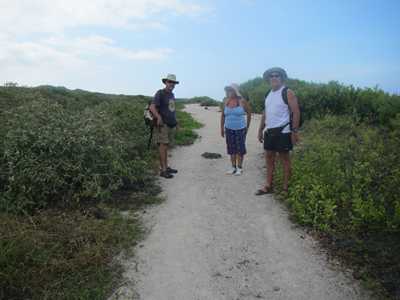 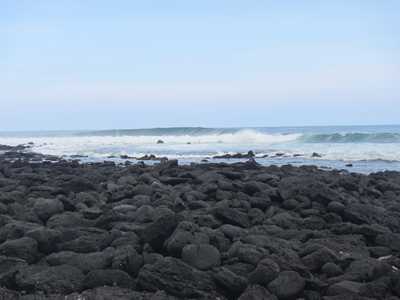 On the beach trail at La
Loberia.
The surf breaks over the dark, volcanic rocks.
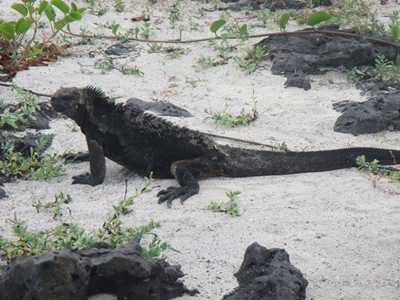
 Marine iguanas soaking up the
sun.
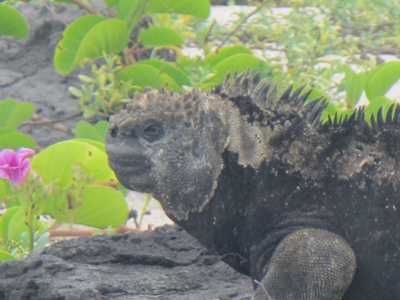
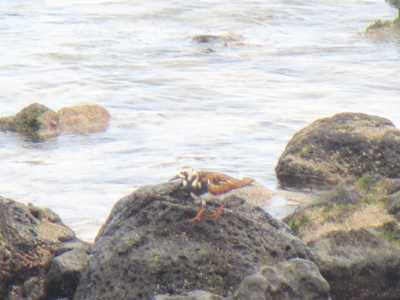 Such a handsome chap!
A Ruddy Turnstone looking for food amongst
the rocks.
After a very enjoyable few hours at La
Loberia we made our way back to the boat, and knowing that we had heard the
anchor chain grating against rocks during our stay, we decided it would be a
good idea to move the boat now instead of tomorrow morning, in case we needed to
manoevre a bit to unwind the chain from a rock. Good move! Not only
was the chain wound around a rock, but it seemed to be caught, maybe over an
overhanging piece.
To add insult to injury, as we were motoring
around, trying to free ourselves, the red ignition light came on on the engine
panel, and when Steve went below to investiagte, he found one of the alternators
hanging off the engine! The bolt holding it on had sheared, probably
because of vibration caused by a missing bush. So now we had to source a
new bolt and a bush and replace the alternator before we could resume
extricating ourselves from the rocks! Whilst investigating this problem,
Steve also found that the raw water pump was leaking and would need to be
replaced. Fortunately we carry a spare, so it was just a case of
unearthing it from the depths of the bilges.
We contacted Manolo at Sharksky, who is the OCC
port officer, and runs a dive company, and asked if he could help out with a
diver and tell us where we could source the necessary hardware to replace the
alternator.
Bolivar arrived at 8 p.m. with our Zarpe and we
explained we wouldn't be able to leave the next day. This did not seem to
be a problem.
So Friday morning Steve went ashore and with
Manolo's help was able to buy a new bolt and order a bush to be made, which
would be ready by 3 p.m. In the meantime he removed and replaced the water
pump. As luck would have it, when looking over the leaking pump he found
that the impellor had two cracked blades, so it was just as well we did change
it. Later in the afternoon he went ashore again and returned with the necessary
hardware and in no time the alternator was back in place.
Manolo said he would come out to the boat on
Saturday morning and give us a hand to free the anchor chain. So we hoped
to be leaving on Sunday.
On Saturday Manolo arrived at low tide and skin
dived down to look at the chain. He helped us to unwrap ourselves from one
rock, but then came up looking very worried. No way will you get out of
this one, he said, the chain is not only wrapped around a rock but it has gone
between two rocks and another seems to have fallen into the gap sealing it in
place. We couldn't believe this - how could it have happened? You
need a diver to take a closer look, he said, and went off to find
one.
Unfortunately, nobody was available until the next
day, so on Sunday morning a guy with diving equipment turned up and went down to
have a look. He confirmed that the chain was indeed jammed and took Steve down
on his buddy regulator so he could see for himself. We could not imagine how the
chain could be trapped by such a neatly fitting heavy rock - it fitted in
like dry-stone walling, almost a perfect fit. We can only
speculate that our chain must have somehow managed to dislodge the topmost rock
which then fell back on top of it. This suggestion is perhaps not too
wierd when you consider the islands are "galloping" east at quite a
rate of 1.5cm a year, so in 50 years the Galapagos will be 1.5 metres nearer
Ecuador! So things are not that stable....
It seemed there was nothing else for it but to cut
the chain. As the diver did not speak any English and our Spanish is
limited we drew up a plan on a piece of paper of how the chain was going to be
cut on either side of the trapped rock. It also meant fixing a line from the
boat to the bit of chain still attached to the anchor, so when we were freed
from the rock we did not drift off and could also recover our anchor! Rod came
over from Sheer Tenacity to lend another pair of hands. The diver used
up two tanks and only managed to cut through half a link! So with three more
cuts still needed he disappeared off saying he was going to get a man with a
machine?!
A short while later a little old guy in a very
tatty wetsuit turned up in yet another boat (now had four hanging off the
stern!), he had a petrol driven compressor and an incredibly long thin hose with
a diving mouthpiece on one end. What is known as a Hookah system, though we have
never seen one with such a long pipe - hopefully his compressor was powerful
enough to push air down to his regulator? The similar systems that cruisers use
for cleaning their hulls have a range of 10+ metres, his coil of tube was
perhaps 100 metres!
Anyway the old guy went down with our hacksaw and
finished off the other three cuts. There was then further discussion
between us on the logistics of recovering two bits of chain and an anchor and
fixing the chain left on the boat to the anchor. In the end it all went very
smoothly. It has caused us no major problems chain wise as we started with 120
metres and now have 80-90 metres (many boats only carry 60m). We can also
connect the chain together at some point in the future when we can buy a pucka
connector.
Eventually we were free, and we re-anchored in a
sandy spot, well away from any rocks! After a very peaceful night's sleep,
we were relieved when the anchor came up without a hitch this morning, and we
are now on our way to Academy Bay in Santa Cruz.
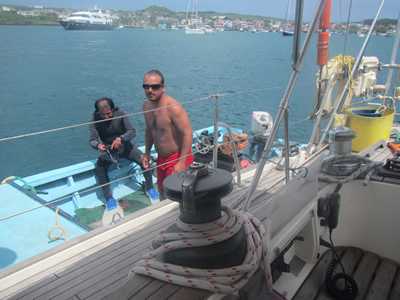 The diver returned with a friend and his
machine!
|